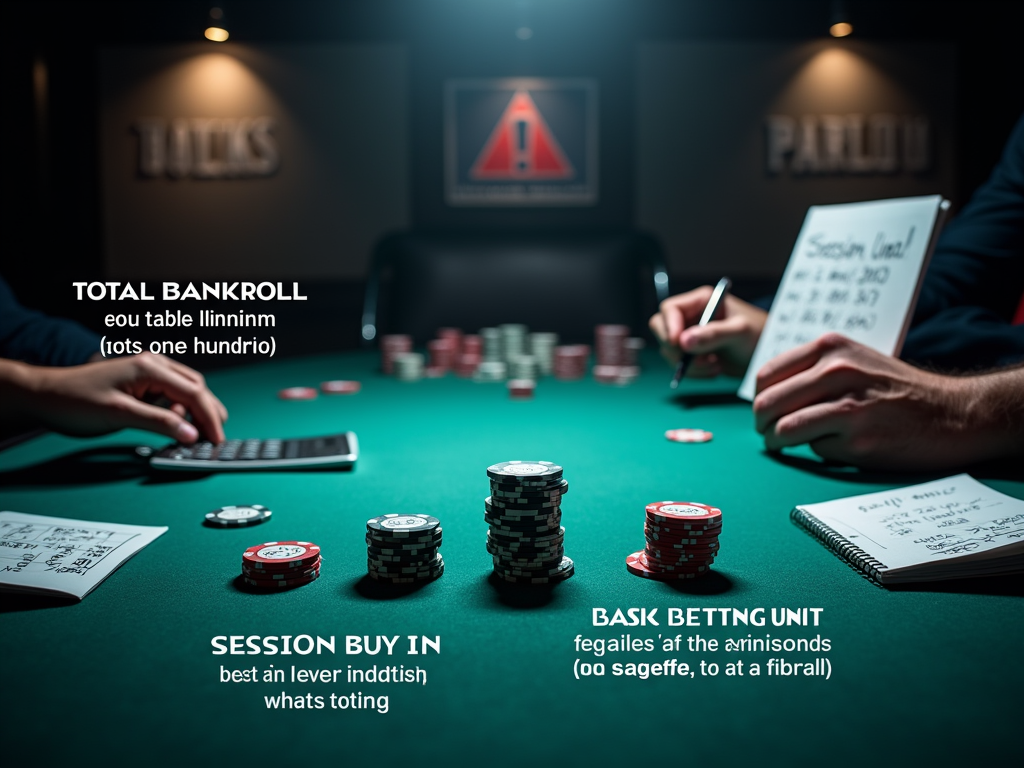Effective Bankroll Management at Blackjack Tables
Effective bankroll management at blackjack tables requires mathematical precision and disciplined decisions to safeguard gambling funds while maximizing entertainment value. A well-managed bankroll acts as a financial shield through clear boundaries between gambling money and living expenses. I implement proven betting formulas that help retain control during winning and losing streaks.
Key Takeaways
- Your total bankroll should be at least 100 times the table’s minimum bet for sustainable play
- Set both win goals (20–50% of buy-in) and loss limits (25–50% of buy-in) before each session
- Choose tables with stakes that match your bankroll — minimum bets should not exceed 5% of your total funds
- Maintain consistent bet sizing and avoid increasing stakes to chase losses
- Track all wins and losses while making decisions based on mathematical probability rather than emotion
My direct approach focuses on practical financial defense through strict limits and clear goals. I base my decisions on proven mathematical formulas instead of emotional reactions. Having clear boundaries protects both gambling and personal finances. Smart bankroll management creates an enjoyable gaming experience through controlled, strategic betting.
This strategic method establishes firm betting rules that adapt to both winning and losing situations. Every bet aligns with predetermined risk parameters. Success depends on staying within set financial bounds while using sound betting practices.
Why Smart Bankroll Management is Your Secret Weapon at Blackjack
The Foundation of Successful Blackjack Play
I’ve learned that bankroll management serves as the backbone of successful blackjack play, creating a structured approach to handling your gambling funds. Think of it as your financial shield—a set of clear rules that protect your money while allowing you to enjoy the game. Just like smart betting strategies in table games, proper bankroll management can make the difference between a short-lived gambling experience and sustainable entertainment.
The math behind blackjack reveals why this matters so much. Even with perfect basic strategy, you’re facing a house edge of about 0.5%. While this is one of the best odds you’ll find in a casino, it still means the house has a slight advantage over time.
Understanding Variance and Long-term Success
Short-term luck can mask the real picture of your blackjack success. That’s where variance comes in—those inevitable ups and downs that can make you feel invincible one day and frustrated the next. I recommend implementing proven betting systems alongside these key bankroll management principles:
- Set clear boundaries between gambling funds and living expenses
- Establish session limits before sitting at the table
- Track wins and losses accurately
- Never chase losses with money you can’t afford to lose
- Adjust bet sizes based on your total bankroll
The players I’ve seen succeed at blackjack consistently share one common trait: they treat their gambling bankroll as a separate entity from their personal finances. By maintaining this separation, they make clearer decisions at the table and avoid emotional betting.
By implementing solid bankroll management, you’re setting yourself up to weather the variance storms. This approach helps maintain control during both winning and losing streaks, ensuring you can continue playing even when luck isn’t on your side.
The reality is that most players who skip proper bankroll management eventually find themselves unable to continue playing, regardless of their skill level. Your skill at basic strategy means little if you don’t have the funds to stay in the game long enough for it to pay off.
Calculate Your Perfect Betting Size Using These Proven Formulas
Setting the right bet size at blackjack is crucial for lasting gameplay and protecting your money. I’ve found that successful bankroll management starts with understanding some key betting formulas that have proven effective over time.
Essential Betting Calculations for Blackjack Success
The foundation of smart bankroll management is the 100x rule – your total gambling funds should be at least 100 times the table’s minimum bet. For instance, if you’re playing at a $10 minimum table, I’d recommend having a $1,000 total bankroll set aside for blackjack.
For individual playing sessions, I suggest bringing between 20-50 times the minimum bet. This means for that same $10 table, you’d want $200-$500 for each session. Your standard betting unit should stay between 1-2% of your session bankroll to maintain control.
Here are the key formulas I use for calculating optimal bet sizes:
- Total bankroll = Table minimum x 100
- Session buy-in = Table minimum x 20-50
- Base betting unit = 1-2% of session bankroll
- Maximum single bet = 5% of session bankroll
While flat betting (keeping bets consistent) offers the safest approach, many players are drawn to progressive betting systems. However, I must caution against popular progressive methods like the Martingale or Paroli systems since they can quickly deplete your bankroll during losing streaks.
For new players especially, I recommend starting with the basic flat betting strategy until you’re comfortable with the game’s flow. This helps build confidence while protecting your bankroll from major swings.
By sticking to these proven formulas and avoiding risky progressive systems, you’ll be better positioned to enjoy longer playing sessions while keeping your bankroll intact. The key is staying disciplined with these betting limits, regardless of whether you’re winning or losing.

Choose the Right Table Stakes to Protect Your Bankroll
Picking suitable table stakes is a fundamental step in protecting your bankroll at the blackjack table. I’ve found that matching your stakes to your available funds helps create a sustainable playing experience while limiting potential losses.
Smart Table Selection Tips
For new players or those with modest bankrolls, I recommend starting at tables with lower minimum bets. A $5 minimum table offers better protection than a $25 table, giving you more hands and playing time with the same bankroll. Here’s what I consider when selecting table stakes:
- Your buy-in should be at least 20 times the minimum bet for adequate coverage
- Look for tables with 3:2 blackjack payouts instead of 6:5 – this reduces the house edge significantly
- Consider the table rules – favorable conditions like dealer standing on soft 17 help preserve your bankroll
- Match the stakes to your comfort level – never feel pressured to play higher than you’re comfortable with
The payouts on blackjack hands make a substantial difference to your bankroll’s longevity. Tables offering 6:5 payouts instead of the traditional 3:2 increase the house edge by around 1.4%, eating into your funds faster. I always recommend checking the posted rules and payouts before sitting down.
Implementing basic betting strategy correctly helps maximize your bankroll’s potential. By making mathematically sound decisions, you’ll reduce unnecessary losses and extend your playing sessions.
When considering table selection, I also pay attention to the betting limits and patterns that suit my style. If the minimum bet represents more than 5% of your total bankroll, it’s better to find a lower-stakes table or build your bankroll first.
Remember that blackjack is a marathon, not a sprint. Smart table selection combined with proper bankroll management gives you the best chance to stay in the game longer and potentially come out ahead.

Set These Smart Limits to Lock in Your Profits
Setting clear financial boundaries at the blackjack table is key to maintaining control and protecting your bankroll. I’ve found that establishing both win and loss limits before starting a session acts as a safety net, helping you avoid costly emotional decisions.
Defining Your Session Parameters
Your loss limit should fall between 25-50% of your initial buy-in amount. Here’s why this range works – it gives you enough wiggle room to weather normal gameplay fluctuations while preventing catastrophic losses. For instance, if you’re starting with $300, your loss limit should be between $75 to $150.
Win goals need similar careful consideration. I recommend setting them between 20-50% of your buy-in. Using our $300 example, aim to walk away once you’re up $60 to $150. These targets strike the sweet spot between being achievable and worthwhile.
The key aspects to remember when setting your limits:
- Lock in a loss limit before your first hand
- Establish a clear win goal upfront
- Track your stack size throughout the session
- Honor your limits strictly – no exceptions
The real challenge isn’t setting these limits – it’s sticking to them. Just like in professional gambling strategies, you need iron discipline. When you hit your win goal, celebrate and step away. If you reach your loss limit, accept it and leave the table.
This structured approach to bankroll management helps prevent the classic gambler’s pitfall of chasing losses or getting greedy during a winning streak. I’ve seen countless players undo hours of profitable play by ignoring their predetermined limits.
Think of these limits as your personal insurance policy. They protect your bankroll during losing sessions while letting you capture profits during winning ones. By removing emotion from the equation, you’ll make clearer decisions and maintain better control over your gambling experience.
Remember that successful blackjack players aren’t just skilled at the game – they’re excellent at managing their money. The discipline to walk away, whether winning or losing, often makes the difference between long-term success and failure at the tables.

Master These Bankroll-Saving Techniques
Smart Money Management Fundamentals
I’ve learned that preserving your bankroll starts with a rock-solid foundation of financial discipline. Only play with money you can afford to lose – this means using disposable income after all bills and responsibilities are covered. Treating blackjack funds as entertainment money rather than a potential income source helps maintain a healthy perspective.
Bet sizing consistency is crucial for avoiding devastating swings. I recommend maintaining steady bet amounts rather than dramatically increasing stakes after losses. This disciplined approach prevents the common pitfall of chasing losses, which can quickly drain your bankroll.
Your physical and mental state directly impacts decision-making at the tables. I strictly avoid playing when tired or under the influence of alcohol. These conditions seriously impair judgment and often lead to costly mistakes – even experienced players make basic errors when not at their sharpest.
Strategic Planning for Extended Play
Planning your bankroll structure based on your playing timeline makes a significant difference. Here are key approaches I’ve found effective for different scenarios:
- Monthly budgeting: Set aside a fixed amount each month specifically for blackjack
- Session limits: Decide on a maximum amount per gaming session
- Trip planning: Calculate a total budget for vacation gambling that includes daily allocations
- Stop-loss limits: Establish clear exit points when reaching predetermined loss thresholds
- Win goals: Set realistic targets for when to walk away with profits
Basic strategy remains your strongest defense against bankroll depletion. I always keep a complete strategy guide handy, whether printed or digital. There’s no shame in referring to charts during play – it’s far better than relying on hunches or incomplete memory.
The right mental approach makes a huge difference in bankroll longevity. I focus on making mathematically sound decisions rather than hoping for lucky streaks. This mindset helps me stick to proven betting systems and avoid impulsive moves that can wreck careful planning.
Rather than trying to win back losses quickly, I concentrate on playing my best game regardless of short-term results. This patient approach helps prevent the spiral of increasing bets that often leads to busted bankrolls.
Setting clear session limits adds structure to your play. I determine both time and money boundaries before sitting down at the table. This prevents the common trap of extending sessions when tired or tilted, which usually leads to poor decisions and unnecessary losses.
Don’t Make These Costly Bankroll Mistakes
Financial Management Red Flags
Playing with money needed for essential expenses is a critical mistake I’ve seen countless players make at the blackjack table. Your rent, utilities, and grocery money should never find their way to the casino floor. Smart bankroll management starts with using only discretionary funds you can afford to lose.
Another costly error is chasing losses or getting overconfident after wins by increasing bet sizes dramatically. This behavior puts your bankroll at unnecessary risk and can quickly deplete your funds. Instead, stick to consistent betting patterns that align with your predetermined bankroll strategy.
Selecting tables with stakes that match your bankroll is crucial. If you’re sitting at a $100 minimum bet table with only $500 to play with, you’re setting yourself up for failure. I recommend choosing tables where your total bankroll is at least 20 times the minimum bet.
Strategic and Emotional Pitfalls
Here are the key mistakes that can drain your bankroll quickly:
- Ignoring your predetermined loss limits once you start playing
- Playing without a solid grasp of basic blackjack strategy
- Making decisions based on gut feelings rather than mathematical probability
- Failing to track your wins and losses accurately
- Mixing alcohol with gambling decisions
- Borrowing money to continue playing after losses
Understanding proper betting systems and maintaining emotional control are essential for preserving your bankroll. I’ve noticed that players who let their emotions guide their decisions typically make larger bets after losses, hoping to recover quickly. This often leads to even bigger losses and can spiral into serious financial trouble.
The most successful players stay disciplined with their betting limits regardless of whether they’re winning or losing. They understand that blackjack is a marathon, not a sprint, and maintain their predetermined betting patterns throughout their session.
Setting clear stop-loss limits before you start playing is vital. Once you hit these limits, it’s time to walk away – no exceptions. Your future self will thank you for this discipline, and your bankroll will live to see another day at the tables.

Sources:
Investopedia – Bankroll Management Guide for Gambling
Blackjack Apprenticeship – How Big Should My Blackjack Bankroll Be
888casino – Blackjack Bankroll Management Explained
American Casino Guide – The Importance of Bankroll Management





